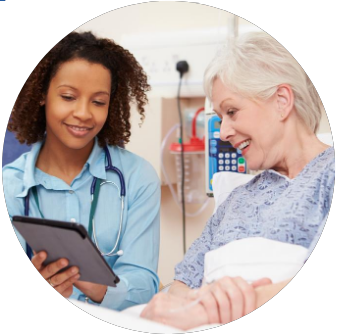Stroke Recovery & Resources
Life After Stroke
Your brain controls how you move, feel, communicate, think and act. Brain injury from a stroke may affect any of these abilities. Some changes are common no matter which side of the brain the injury is on. Others are based on which side of the brain the stroke injures.
What are the most common general effects of stroke?
• Hemiparesis (weakness on one side of the body) or hemiplegia (paralysis on one side of the body)
• Dysarthria (difficulty speaking or slurred speech), or dysphagia (trouble swallowing)
• Fatigue
• Loss of emotional control and changes in mood
• Cognitive changes (problems with memory, judgment, problem-solving or a combination of these)
• Behavior changes (personality changes, improper language or actions)
• Decreased field of vision (inability to see peripheral vision) and trouble with visual perception
What are common changes with a left-brain injury?
• Paralysis or weakness on the right side of the body.
• Aphasia (difficulty getting your words out or understanding what is being said).
• Behavior that may be more reserved and cautious than before.
What are common changes with a right-brain injury?
• Paralysis or weakness on the left side of the body.
• One-sided neglect which is a lack of awareness of the left side of the body. It may also be a lack of awareness of what is going on to the survivor’s left. For example, they may only eat from the right side of their plate, ignoring the left side.
• Behavior may be more impulsive and less cautious than before.
• It may be harder for the survivor to understand facial expressions and tone of voice. They also may have less expression in their own face and tone of voice when communicating.
What are common emotional effects of stroke?
• Depression
• Apathy and lack of motivation
• Frustration, anger and sadness
• Pseudobulbar affect, also called reflex crying or emotional lability (emotions may change rapidly and sometimes not match the mood)
• Denial of the changes caused by the brain injury
Will I get better?
In most cases people do get better over time. The effects of a stroke are greatest right after the stroke. From then on, you may start to get better. How fast and how much you improve depends on the extent of the brain injury and your rehabilitation.
• Some improvement occurs spontaneously and relates to how the brain works again after it’s been injured.
• Stroke rehabilitation (rehab) programs help you improve your abilities and learn new skills and coping techniques.
• Rehab begins after the stroke is over and you’re medically stable.
• Depression after stroke can interfere with rehab. It’s important to treat depression.
• Improvement often occurs most quickly in the first months after a stroke. Then it continues over years, perhaps at a slower pace, with your continued efforts.
WHEN THE IMMEDIATE CRISIS OF A STROKE HAS PASSED AND YOU'VE BEEN STABILIZED MEDICALLY, IT MAY BE A GOOD TIME TO CONSIDER REHABILITATION (REHAB) THERAPY.

The Stroke Caregiver
People who provide help for stroke survivors are often called caregivers. Everyone involved in helping a stroke survivor is a caregiver. It can be the spouse, family members or friends. Often one person, spouse, adult child or parent, will provide most of the care. It’s important that caregivers and stroke survivors strive to be “care partners” in their efforts. It’s often a challenge for both to adjust to their changed roles. The adjustment may be easier if the caregiver and stroke survivor share in decision-making as much as possible and try to share their feelings honestly.
What should a caregiver do?
There is no one “job description” that explains what all caregivers do. Each caregiver’s responsibilities vary according to the unique needs of the stroke survivor. Role changes and new skills may need to be learned.
Is there assistance for caregivers?
Many people find caring for another person very rewarding. But there may be times when a stroke survivor’s needs are too much for any one person. Sometimes a caregiver just needs a break and there are many different avenues for providing care while the primary caregiver is away. These include: adult day care centers, meal programs such as Meals on Wheels, home health aides, and respite care.

You are not alone in your recovery from stroke.
Most stroke survivors are able to return home and resume many of the activities they did before the stroke. Leaving the hospital may seem scary at first because so many things have changed. Our staff can help prepare you to go home or to another setting that can better meet your needs.
Patient Resources
How do I know if going home is the right choice?
Going home poses few problems for people who have had a minor stroke and have few lingering effects. For those whose strokes were more severe, going home depends on these four factors:
• Ability to care for yourself. Rehabilitation should be focused on daily activities.
• Ability to follow medical advice. It’s important to take medication as prescribed and follow medical advice.
• A caregiver. Someone should be available who is willing and able to help when needed.
• Ability to move around and communicate. If stroke survivors aren’t independent in these areas, they may be at risk in an emergency or feel isolated.
There are many resources locally and nationally to help you and your loved ones understand stroke, meet other stroke survivors, and access stroke support.
